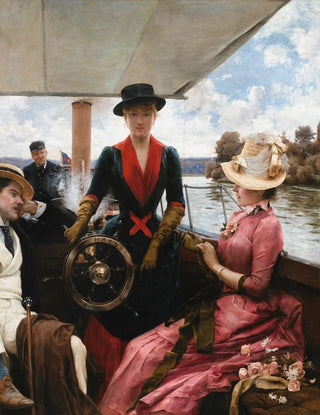Art print | Full speed - Julius LeBlanc Stewart


View from behind

Frame (optional)
In the fascinating universe of art, some works manage to capture the very essence of an era, evoke intense emotions, and inspire wonder. "Pleine vitesse - Julius LeBlanc Stewart" is undoubtedly one of these iconic creations. Through this canvas, the artist immerses us in a world where speed and the dynamism of modern life are highlighted with such intensity that they seem almost tangible. The depicted scene, vibrant and lively, transports the viewer to a suspended moment, where movement and light meet to create an unforgettable visual harmony. This painting is not merely a depiction of a fleeting moment but a true celebration of life, movement, and the energy that animates it.
Style and uniqueness of the work
Julius LeBlanc Stewart's style is distinguished by his ability to combine realism and impressionism, offering a unique vision of the world around him. In "Pleine vitesse," one can observe mastery of colors and light play that make the scene almost alive. The brushstrokes, both delicate and bold, create a rich texture that invites the viewer to dive into the work. The composition is carefully orchestrated, with each element of the canvas contributing to the overall dynamic. The human figures, depicted with great expressiveness, seem to come to life before our eyes, while the surrounding landscape, though secondary, plays a crucial role in staging this effervescence. Stewart manages to capture not only physical movements but also emotions, making his work deeply touching and accessible.
The artist and his influence
Julius LeBlanc Stewart, a prominent figure in 19th-century American art, established himself through his talent and artistic vision. Raised in an environment where art was valued, he benefited from solid training that allowed him to explore various techniques and styles. His stay in Europe, particularly in Paris, was decisive in his career, enabling him to absorb the artistic currents of his time. Stewart was able to incorporate these influences while developing a distinctive signature, characterized by meticulous attention

Matte finish

View from behind

Frame (optional)
In the fascinating universe of art, some works manage to capture the very essence of an era, evoke intense emotions, and inspire wonder. "Pleine vitesse - Julius LeBlanc Stewart" is undoubtedly one of these iconic creations. Through this canvas, the artist immerses us in a world where speed and the dynamism of modern life are highlighted with such intensity that they seem almost tangible. The depicted scene, vibrant and lively, transports the viewer to a suspended moment, where movement and light meet to create an unforgettable visual harmony. This painting is not merely a depiction of a fleeting moment but a true celebration of life, movement, and the energy that animates it.
Style and uniqueness of the work
Julius LeBlanc Stewart's style is distinguished by his ability to combine realism and impressionism, offering a unique vision of the world around him. In "Pleine vitesse," one can observe mastery of colors and light play that make the scene almost alive. The brushstrokes, both delicate and bold, create a rich texture that invites the viewer to dive into the work. The composition is carefully orchestrated, with each element of the canvas contributing to the overall dynamic. The human figures, depicted with great expressiveness, seem to come to life before our eyes, while the surrounding landscape, though secondary, plays a crucial role in staging this effervescence. Stewart manages to capture not only physical movements but also emotions, making his work deeply touching and accessible.
The artist and his influence
Julius LeBlanc Stewart, a prominent figure in 19th-century American art, established himself through his talent and artistic vision. Raised in an environment where art was valued, he benefited from solid training that allowed him to explore various techniques and styles. His stay in Europe, particularly in Paris, was decisive in his career, enabling him to absorb the artistic currents of his time. Stewart was able to incorporate these influences while developing a distinctive signature, characterized by meticulous attention






